In recent posts I highlighted some great training videos on suturing and on one and two handed knot tying. In this post I will recommend a video tutorial for instrument tying. As with the other suturing and knot tying skills, it is very important that medical students learn early in their careers how to instrument tie. This is the bread and butter of knot tying. If you are proficient with the instrument tie you will impress residents and attendings and they will be much more willing to give you responsibilities in the OR. The video below is a straight forward review and tutorial of the instrument tie. As with all other knots, remember that a square knot is not complete until you have made two opposing throws; otherwise you are tying granny knots.
Monthly Archive: October 2011
One and two handed surgical knot tying: A video tutorial
In two recent posts I recommended some great video tutorials for suturing and for instrument tying. This post will focus on learning how to tie one and two handed knots in the operating room. As with previous skills, it is very important that medical students learn to tie surgical knots early in their training. Let me offer one experience from medical school to illustrate this fact. This is a true story.
After finishing rounds with the residents on my OB rotation I was assigned to work in the OR with the chief of benign gynecology surgery at a community hospital. He also happened to be the rotation coordinator and was responsible for my grade and evaluation. The first case was an open tubal ligation. As the case was ending the attending turned to me and said, “hey, we have to close the fascia, can you tie knots?” Luckily, I knew quite well how to tie. I picked up the suture and threw a few two handed knots down. My attending was seriously impressed and told everyone on the team. He gave me a raving evaluation and spoke specifically about how I was “well prepared for the OR.” So, take it from me, learn these knots! Always remember Rule #1: tie square knots, not granny knots! Two throws are required to complete the knot.
1. The two handed knot. This is the knot that you will actually use in the OR. Most surgeons never tie one-handed knots and some even forbid them. So, this should be your bread and butter. After watching a few tutorial videos I am convinced that this is the best. It comes from the University of Texas at Houston and walks you through the basics. The audio is very good, so find some earphones. Always remember that a square not requires two throws to be completed.
2. The one handed knot: This is a more confusing knot and far less high yield because very few surgeons ever use it or expect it. It is notoriously difficult to teach and to learn. The best video I have found is shown below. Unlike the previous video, there is not audio to walk you through the knot. Rather, the knot is completed slowly and each difficult section is repeated. Remember, you must tie two throws to make a complete square knot. This is important when tying a one handed knot because the two throws are completed using two different techniques.
Finally, there is more than one way to tie a square knot. Here is one more video that demonstrates the two handed and one handed method clearly. Similar to the second video, there is no audio. Go get some gloves and some suture and practice along with this video.
How to suture a wound: A video tutorial
Before you start your third year of medical school you absolutely need to know how to suture. In this post I will provide some of the best video tutorials for suturing. (See my other posts to review one and two hand surgical knots and instrument tying.) During my general surgery rotation and OB/GYN countless attendings and residents would look at me as the case was ending and say, “hey med student, can you suture? Will you close while I dictate?” I was also asked to suture quite a few lacerations during my ED rotation. Learn early and learn often. Your school will likely have a suturing training course, but you need to keep fresh. I recommend the two videos listed below as tutorials. The first (not youtube, so you have to click on it) is the most professional and has some images to help understand the mechanics.
Video 1: From medicanalife.com
Video 2:
It is also very important to know a few common pimping questions (below). The Medscape website offers a very good and very free review of all of these questions.
- The indications for suturing vs. glue vs. healing by secondary intention
- Time to removal of stitches
- Types of suture, and when to use each
- How and when to use lidocaine and/or epinephrine prior to suturing
- Lethal dose of lidocaine (I have been pimped on this at least 10 times)
Top 10 Most Disgusting Medical Conditions
As a medical student and now as a resident, I feel quite comfortable with the day-to-day gross diagnoses in the hospital. In fact, until last week I was convinced that nothing phased me anymore. That was until a patient with myiasis walked into my hospital, and I nearly lost my lunch. The episode has made me think: what is the most disgusting diagnosis in medicine….is there anything more gross than myiasis? Well, after thinking about all the cases I have seen and looking at some gut wrenching images, I have come up with my Top Ten Most Disgusting Medical Conditions.
WARNING: THE IMAGES BELOW REPRESENT REAL MEDICAL PROBLEMS AND ARE EXPLICIT IN NATURE. DO NOT VIEW THESE IMAGES UNLESS YOU ARE PREPARED TO FEEL QUEASY.
1o. Hidradenitis Suppurativa:
A chronic inflammatory condition of the apocrine sweat glands, usually in the axilla (arm pit). It does not matter how many times you cut it out, it will always come back.
9. Fecaluria:
The passage of fecal matter through the urethra. The condition usually develops via a vesicointestinal fistula, or a connection between the bladder and the intestine.
8. Fecal Vomiting:
This can occur in very sick patients, usually due to a bowel obstruction or a gastrocolic fistula (connection between the stomach and the colon). No one wants to see a real picture of this…

7. Fulminant Human Papilloma Virus (HPV) Infection:
HPV causes most warts on our body, including the sexually transmitted forms. However, there is a rare genetic disese called Epidermodysplasia verruciformis which allows HPV to take over a person’s body. You may have heard of Dede Koswara, or “The Tree Man”, who suffered from this disorder, check out his story on ABCNews.

Note: I believe this disease is the same, or related to Keratosis Palmoplantaris…see image below
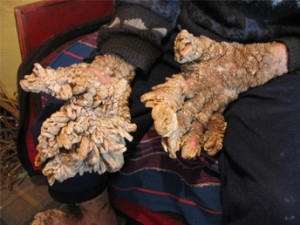
6. Cancrum Oris:
Also known as “Noma Disease”, this is a gangrenous infection that leads to destruction of the mouth and face. The disease is common in African youth.

5. Tapeworm (Cestoda):
Parasitic flatworms are not as uncommon as you might think. They live in your small intestine for years at a time, laying eggs and feasting off host blood and feces. One worm can go from egg to 15 foot long adult in only a few months. They can be contracted from eating under cooked meats, especially pork. One species, Taenia saginata, which infects cows and humans, has been found to grow up to 40 feet long.
4. Echinococcosis:
Also known as hydatid disease, this is another parasitic tapeworm infection, which an twist. When the Echinococcis granulosus worm infects a host, it creates an other-worldly cyst in the body. The cyst continues to expand until it is either removed, or overcomes the host. More disturbing is that the echinococcosis loves to make its home in the host brain. The image below shows the removal of a hydatid cyst from the abdomen. This movie depicts removal of a cyst from the brain and is a very graphic, real-life example of how large the cysts in the brain get, and how they are removed.

3. Bed Bug Infestation:
Why is the Cimicidae parasite so high on the list? If you are asking that question, you have never seen a real infestation. While I was a fourth year medical student I was riding with an EMS team when we picked up a homeless man to bring to the hospital. While enroute to the ED we noticed hundreds of red sores. When asked about the wounds, the man did not know anything about them. Two minutes into the drive I saw movement around the man’s waistline. All of the sudden, 25-30 bed bugs crawled out of his pants and started doing their business on his belly and legs. The man felt nothing. I grabbed one bug with a towel to verify the infestation. Instantly, all 30 bugs rushed right back into the mans pants. If you don’t think a full on Cimicidae infection is gross….just wait until you see one. You will itch for a month.
2. Ascariasis:
The great white parasitic roundworm. Though not as common nor as long as her tapeworm counterpart, Ascariasis are far more cruel. Contracted from eating ascariasis fecal matter, the larvae hatch in your gut, they dig through your intestines, eat through your lungs, move into your respiratory tract, and get reswallowed into your gut where they grow very large and very numerous. The worms can grow up to 1 foot in length, measuring inches in circumference, and there may be hundreds in one intestine. The image below is an intestine that has been opened up after surgery.
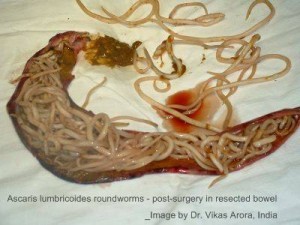
The most disgusting medical diagnosis…
1. Myiasis:
Maggots eating your flesh…and you don’t even know it! How do flies get in your body to lay eggs in the first place? How do people not realize there are hundreds of maggots eating their dying skin? How does it all happen? I don’t know, but the simple thought of the whole cycle makes me feel queasy. One interesting fact is that the use of maggot therapy is on the rise. Some physicians are beginning to adopt a century old practice of cleaning necrotic wounds with maggots…interesting. If you are really brave, check out the video published in BMC Surgery of a surgeon removing multiple maggots from a woman chest.
Honorable Mention:
Hypertrichosis:
“Werewolf Disease” is a genetic syndrome resulting in hear growth on every inch of your body.

Dracunculiasis:
Or “Guinea Worm Disease” results from long skinny roundworms that live in blisters in the legs and feet.
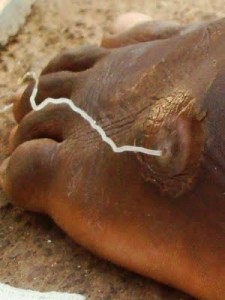
Filariasis:
Another roundworm disease, this one causes blockage of your lymphatic vessels leading to elephantiasis.

Book Review: How Doctors Think (2007)
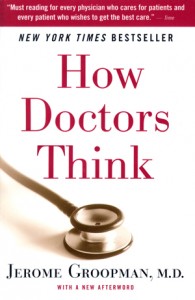 Dr. Jerome Groopman is an internal medicine physician at Harvard Medical School and has written a number of best selling books as well as frequent columns in The New Yorker. His recent book, How Doctors Think, is another New York Times bestseller and has received rave reviews from most sources. I read this book during my fourth year of medical school and wished I read it earlier. The book delves into the art of diagnosis and treatment and focuses on parts of these skills that are rarely discussed in medical school. Dr. Groopman explains that many of the decisions we make as physicians depend on inner feelings and tendencies that even we are not always aware of. If physicians are able to understand these tendencies, we will be better equipped to make correct decisions and less likely to make incorrect ones. This is a very good book, one that will help medical students in their career and one that will allow patients to better understand their doctor. I highly recommend it. Below is Dr. Groopman’s biography from Amazon.com…
Dr. Jerome Groopman is an internal medicine physician at Harvard Medical School and has written a number of best selling books as well as frequent columns in The New Yorker. His recent book, How Doctors Think, is another New York Times bestseller and has received rave reviews from most sources. I read this book during my fourth year of medical school and wished I read it earlier. The book delves into the art of diagnosis and treatment and focuses on parts of these skills that are rarely discussed in medical school. Dr. Groopman explains that many of the decisions we make as physicians depend on inner feelings and tendencies that even we are not always aware of. If physicians are able to understand these tendencies, we will be better equipped to make correct decisions and less likely to make incorrect ones. This is a very good book, one that will help medical students in their career and one that will allow patients to better understand their doctor. I highly recommend it. Below is Dr. Groopman’s biography from Amazon.com…
Jerome Groopman, M.D., holds the Dina and Raphael Recanati Chair of Medicine at Harvard Medical School and is chief of experimental medicine at Beth Israel Deaconess Medical Center in Boston. He has published more than 150 scientific articles. He is also a staff writer at The New Yorker and has written editorials on policy issues for the New Republic, the Washington Post, and the New York Times. His previous books include the New York Times bestseller The Anatomy of Hope, Second Opinions, and The Measure of Our Days. Groopman lives in Brookline, Massachusetts.
Book Review: Over our Heads (2011)
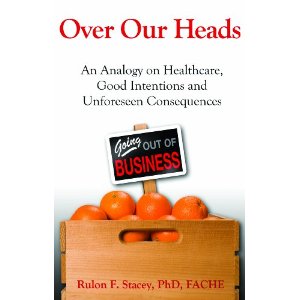 Dr. Rulon Stacey, PhD is the president and CEO of Poudre Valley Health System, he is the current president of the American College of Health Care Executives, and recently won the Malcolm Baldrige Award presented by President Obama. He recently published a new book: Over Our Heads: An Analogy on Healthcare, Good Intentions and Unforeseen Consequences, which outlines some of the problems with health care in our country. In the book he uses an allegory of a grocery store owner to explain how government regulation has created a cumbersome and expensive health care system that is near the brink of failure. He cites specific government bills and describes how each of them has affected the health care system. The allegory allows the layperson to understand some of the difficult nuances of health care and government regulation. I think this is an extremely important book written by a man who knows the system as well as anyone else. I recommend the short read to all medical students and everyone else. Below is the official book description from Amazon.
Dr. Rulon Stacey, PhD is the president and CEO of Poudre Valley Health System, he is the current president of the American College of Health Care Executives, and recently won the Malcolm Baldrige Award presented by President Obama. He recently published a new book: Over Our Heads: An Analogy on Healthcare, Good Intentions and Unforeseen Consequences, which outlines some of the problems with health care in our country. In the book he uses an allegory of a grocery store owner to explain how government regulation has created a cumbersome and expensive health care system that is near the brink of failure. He cites specific government bills and describes how each of them has affected the health care system. The allegory allows the layperson to understand some of the difficult nuances of health care and government regulation. I think this is an extremely important book written by a man who knows the system as well as anyone else. I recommend the short read to all medical students and everyone else. Below is the official book description from Amazon.
Costs continue to soar, and Americans already crippled by a sluggish economy struggle to pay escalating insurance premiums. Politicians, entertainers, and other public figures regularly demonize healthcare professionals as the ones who created this situation through either greed or mismanagement. Meanwhile, it seems as though government solutions just make things worse, and the problems keep piling up.
How did we get to this point? According to Rulon Stacey author of Over Our Heads: An Analogy on Healthcare, Good Intentions and Unforeseen Consequences the roots of the problem are inseparable from the solution. Government intervention, meant to make healthcare more accessible and affordable, has instead created a system so convoluted and complex that we can no longer keep up with current policy.
This book is Stacey's attempt to describe, in a concise and relatable way, where our national healthcare policy went wrong. His analogy centers on a grocery store in the fictional town of Capital Springs and details what happens when the city government decides to issue food vouchers in order to help the community s poor and then gradually begins to reduce their reimbursement.
As the mayor tinkers with the program, the results of his actions lead to higher prices, inadequate distribution, and a situation analogous to where healthcare finds itself right now. The book ends with the election of an even more generous mayor and a grim prediction of what will happen to the industry if current public policy remains unchanged.
Readers will learn three key lessons:
1. Government intervention, fueled by good intentions, caused this crisis.
2. Current public policy is based on faulty information and should be evaluated.
3. If left unchecked, health reform will continue to promise more healthcare for less reimbursement…and the whole system will surely collapse on itself.This book will be welcomed by healthcare professionals searching for a way to tell their story, political reformers building a case for change, students seeking a defined case study on the healthcare cost crisis, and citizens seeking insights on how we got so far in over our heads and where we re likely to end up.
Movie Review: Gross Anatomy (1989)
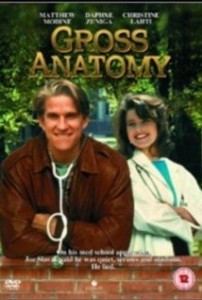 Gross Anatomy provides an interesting mix of cheesy 80’s drama with first year medical student drama. The movie follows an arrogant first year medical student who cares more about pursuing his cute lab partner than his medical degree. Though the settings and curriculum in the movie are a bit out-dated, the medical student drama is quite realistic. This is an OK movie that might provide some entertainment once you have finished your gross anatomy dissections and need a few laughs.
Gross Anatomy provides an interesting mix of cheesy 80’s drama with first year medical student drama. The movie follows an arrogant first year medical student who cares more about pursuing his cute lab partner than his medical degree. Though the settings and curriculum in the movie are a bit out-dated, the medical student drama is quite realistic. This is an OK movie that might provide some entertainment once you have finished your gross anatomy dissections and need a few laughs.
Here is the plot synopsis from IMDB…
Joe Slovak (Modine) is a brilliant first-year med student whose nonconformist approach to life is tested when he enrolls in gross anatomy, the toughest course in med school. Joe’s freewheeling, independent style creates funny moments in the classroom, but puts him at odds with his demanding professor (Christine Lahti), who questions whether her class “rebel” has what it takes to be a doctor. Meanwhile, Joe falls in love with his lab partner Laurie (Daphne Zuniga), who won’t let anything, especially romance, interfere with her plans. And while Joe’s never done anything by the book, he proves he does have what it takes to succeed – without changing his ways!
Top Ten Books for First Year Medical Students
This list is part of a series of articles about the best books for medical students. Click on the Med School Books Main Page to see other lists including the best books for each year in medical school, the best books for each clinical rotation, and the best books for USMLE Steps 1, 2, and 3.
- Updated April 2015
In this list I will review books used in the basic science courses in medical school. If you are interested in microbiology, pharmacology, and systems based books check out my list of the Top Ten Books for Second Year Medical Students.
1. Netter's Atlas of Human Anatomy:
|
|
2. Med School Confidential:
|
|
3. Netter's Anatomy Flash Cards:
|
|
4. Clinically Oriented Anatomy:
|
|
5. Grant's Dissector:
|
|
6. High Yield Embryology:
|
|
7. Lippincott's Illustrated Review of Biochemistry:
|
|
8. First Aid for the Basic Sciences, General Principles:
|
|
9. First Aid for the USMLE Step 1:
|
|
10. Kaplan's USMLE Step 1 Lecture Notes:
|
Histology Websites
Histology is an extremely important topic during medical school, both in the pre-clinical years as you study anatomy and pathology, and during the clinical years when you are diagnosing patients. Many questions during school, including all three parts of the USMLE or COMLEX test will include histologic slides and ask for diagnosis or interpretation. It is imperative that all medical students get a solid foundation in histology. Years ago, most student would purchase histology textbooks. However, recently, a number of medical schools have created free and easy-to-use websites for studying histology. If you are still a book person, let me suggest Histology: A Text and Atlas which has great slides and explanations. Otherwise, if you are like me and would like to save the money, let me outline some of the best histology review sites on the internet.
If you don’t want to spend the money and don’t mind using websites to study, let me recommend two fantastic histology websites
- The Boston University Histology Learning System. The absolute best review of histology on the web. If you know of a better website please let me know, I doubt there can be one. They have hundreds of slides and tutorials categorized by organ system. I found this site late in my medical school career, otherwise I would have used it routinely.
- The University of Utah Department of Anatomy/Histology Tutorial. I recently wrote short post specifically about the anatomy and pathology reviews on this website. In addition to these reviews, there are a small number great slides and explanations for most stains and systems.
- The University of Florida Histology Tutorial: This website is older and does not boast as many images as the previous sites. However, the site does provide a quiz mode and tutorial mode that allows learners to see and locate hundreds of different structures.
- Kansas City University Histology Review: Titled “Ed’s Basic Histology Review” this site will not win any web-design awards. However, its simple layout and high yield facts make it a quick and great study resource.
If you know of other great websites, please let me know.





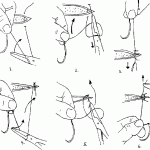

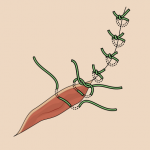
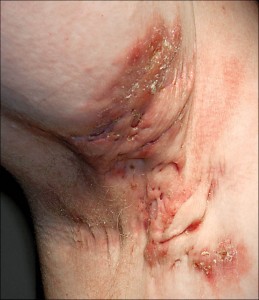
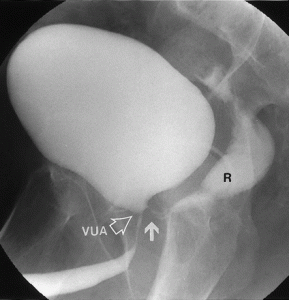
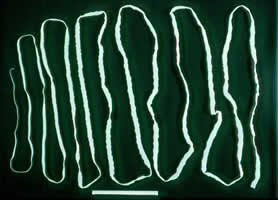

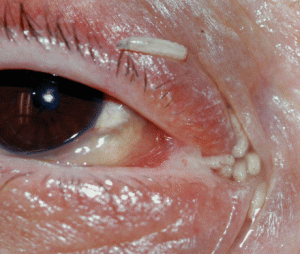

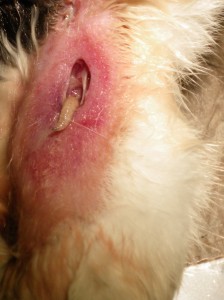

 My name is Andrew and I am a first year resident training to be an ophthalmologist. I created ShortWhiteCoats to provide medical students, residents, and the public with all the information I spent so many hours looking for during medical school.
My name is Andrew and I am a first year resident training to be an ophthalmologist. I created ShortWhiteCoats to provide medical students, residents, and the public with all the information I spent so many hours looking for during medical school.







